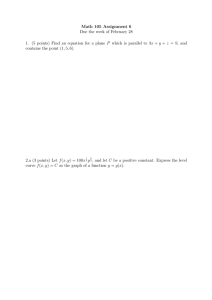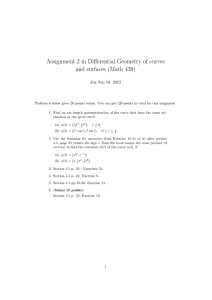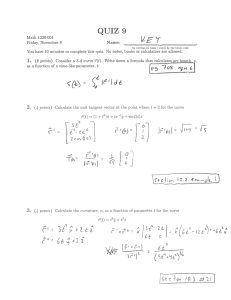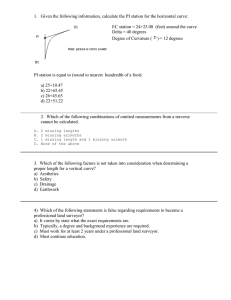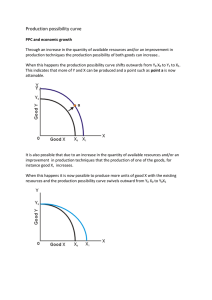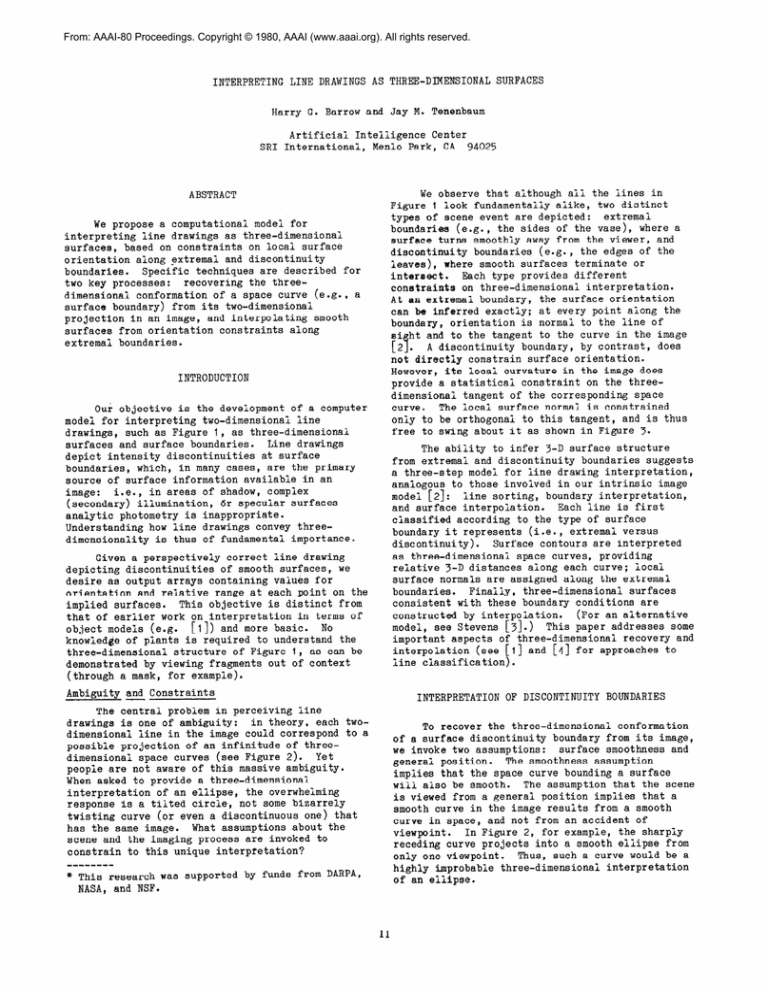
From: AAAI-80 Proceedings. Copyright © 1980, AAAI (www.aaai.org). All rights reserved.
INTERPRETING LINE DRAWINGS AS THREE-DIMENSIONAL SURFACES
Harry G. Barrow and Jay M. Tenenbaum
Artificiai Inteiiigence Center
SRI Internationai, Menio Park, CA 94025
ABSTRACT
We propose a computationai modei for
interpreting iine drawings as three-dimensionai
surfaces, based on constraints on iocai surface
orientation aiong extremai and discontinuity
boundaries. Specific techniques are described for
two key processes: recovering the threedimensionai conformation of a space curve (e.g., a
surface boundary) from its two-dimensionai
projection in an image, and interpoiating smooth
surfaces from orientation constraints aiong
extremai boundaries.
INTRODUCTION
Our objective is the deveiopment of a computer
modei for interpreting two-dimensionai iine
drawings, such as Figure 1, as three-dimensionai
surfaces and surface boundaries. Line drawings
depict intensity discontinuities at surface
boundaries, which, in many cases, are the primary
source of surface information avaiiabie in an
image: i.e., in areas of shadow, compiex
(secondary) iiiumination, or specuiar surfaces
anaiytic photometry is inappropriate.
Understanding how iine drawings convey threedimensionaiity is thus of fundamentai importance.
Given a perspectiveiy correct iine drawing
depicting discontinuities of smooth surfaces, we
desire as output arrays containing vaiues for
orientation and reiative range at each point on the
impiied surfaces. This objective is distinct from
that of eariier work on interpretation in terms of
object modeis (e.g. [I]) and more basic. No
knowiedge of piants is required to understand the
three-dimensionai structure of Figure 1, as can be
demonstrated by viewing fragments out of context
(through a mask, for exampie).
We observe that aithough aii the iines in
Figure 1 iook fundamentaiiy aiike, two distinct
types of scene event are depicted: extremai
boundaries (e.g., the sides of the vase), where a
surface turns smoothiy away from the viewer, and
discontinuity boundaries (e.g., the edges of the
ieavss), where smooth surfaces terminate or
interswt.
Each type provides different
constraints on three-dimensionai interpretation.
At an extremai boundary, the surface orientation
can be inferred exactiy; at every point aiong the
boundary, orientation is normai to the iine of
si ht and to the tangent to the curve in the image
A discontinuity boundary, by contrast, does
d.
not dirsctiy constrain surface orientation.
However, its iocai curvature in the image does
provide a statisticai constraint on the threedimension& tangent of the corresponding space
curve. The iocai surface normai is constrained
oniy to be orthogonai to this tangent, and is thus
free to swing about it as shown in Figure 3.
The abiiity to infer 3-D surface structure
from extremai and discontinuity boundaries suggests
a three-step modei for iine drawing interpretation,
anaiogous to those invoived in our intrinsic image
modei [2]: iine sorting, boundary interpretation,
and surface interpoiation. Each iine is first
ciassified according to the type of surface
boundary it represents (i.e., extremai versus
discontinuity). Surface contours are interpreted
as three-dimensionai space curves, providing
reiative 3-D distances aiong each curve; iocai
surface normais are assigned aiong the extremai
boundaries. Finaiiy, three-dimensionai surfaces
consistent with these boundary conditions are
constructed by interpoiation. (For an aiternative
model, see Stevens
[3].)
This paper addresses some
important aspects of three-dimensionai recovery and
interpoiation (see [l] and [4] for approaches to
iine ciassification).
Ambiguity and Constraints
INTERPRETATION OF DISCONTINUITY BOUNDARIES
The centrai probiem in perceiving iine
drawings is one of ambiguity: in theory, each twodimensionai iine in the image couid correspond to a
possibie projection of an infinitude of threedimensionai space curves (see Figure 2). Yet
peopie are not aware of this massive ambiguity.
When asked to provide a three-dimensionai
interpretation-of an eiiipse, the overwheiming
response is a tiited circie, not some bizarrely
twisting curve (or even a discontinuous one) that
What assumptions about the
has the same image.
scene and the imaging process are invoked to
constrain to this unique interpretation?
To recover the three-dimensionai conformation
of a surface discontinuity boundary from its image,
we invoke two assumptions: surface smoothness and
generai position. The smoothness
assumption
impiies that the space curve bounding a surface
wiii aiso be smooth. The assumption that the scene
is viewed from a generai position impiies that a
smooth curve in the image resuits from a smooth
curve in space, and not from an accident of
viewpoint. In Figure 2, for exampie, the sharpiy
receding curve projects into a smooth eiiipse from
oniy one viewpoint. Thus, such a curve wouid be a
highiy improbabie three-dimensionai interpretation
of an eiiipse.
* This research was supported by funds from DARPA,
NASA, and NSF.
11
The problem now is to determine which smooth
space curve is most iikeiy. For the speciai case
of a wire curved in space, we conjectured that, of
aii projectiveiy-equivaient space curves, humans
perceive that curve having the most uniform
curvature and the ieast torsion [2]; i.e., they
perceive the space curve that is smoothest and most
planar. Consistent findings were reported in
recent work by Witkin [5] at MIT on human
interpretation of the orientation of pianar ciosed
curves.
Measures -of Smoothness
The smoothness of a space curve is expressed
quantitativeiy in terms of intrinsic
characteristics such as differentiai curvature (k)
and torsion (t), as weii as vectors giving
intrinsic axes of the curve: tangent (T),
principai normai (N), and binormai (B). A simpie
measure for the smoothness of a space curve is
uniformity of curvature. Thus, one might seek the
space curve corresponding to a given image curve
for which the integrai of k' (the spatiai
derivative of k) was minimum. This aione, however,
is insufficient, since the integrai of k' couid be
made arbitrariiy smaii by stretching out the space
curve so that it approaches a twisting straight
iine (see Figure 4).
Uniformity of curvature aiso
does not indicate whether a circuiar arc in the
image shouid correspond to a 3-D circuiar arc or to
part of a heiix. A necessary additionai constraint
in both cases is that the space curve corresponding
to a given image curve should be as pianar as
possibie, or more preciseiy that the integrai of
its torsion shouid aiso be minimized.
The program was tested using input coordinates
synthesized from known 3-D space curves so that
resuits couid be readiiy evaiuated. Correct 3-D
interpretations were produced for simpie open and
ciosed curves such as an eiiipse, which was
interpreted as a tiited circle, and a trapezoid,
which was interpreted as a tiited rectangie.
However, convergence was siow and somewhat
dependent on the initiai choice of z-vaiues. For
exampie, the program had difficuity converging to
the "tiited-circie" interpretation of an eiiipse if
started either with aii z-vaiues in a piane
paraiiei to the image piane or aii randomized to be
highiy nonpianar.
Integrai 1 expresses both the smoothness and
pianarity of a space curve in terms of a singie,
iocaiiy computed differentiai measure d(kB)/ds:
d(kB/ds)*ds =
(kg2 + k2t2)ds
(1)
Intuitiveiy, minimizing this integrai
corresponds to finding the three-dimensionai
projection of an image curve that most cioseiy
approximates a pianar, circular arc, for which k'
and t are both everywhere zero.
SURFACE INTERPOLATION
Given constraints on orientation aiong
extremai and discontinuity boundaries, the next
probiem is to interpoiate smooth surfaces
consistent with these boundary conditions. The
probiem of surface interpoiation is not pecuiiar to
contour interpretation, but is fundamentai to
surface reconstruction, since data is generaiiy not
avaiiabie at every point in the image. We have
impiemented a soiution for an important case: the
interpoiation of approximateiy uniformiy-curved
surfaces from initiai orientation values and
constraints on orientation [6].
Recovery Techniques
A computer modei of this recovery theory was
impiemented to test its competence. The program
accepts a description of an input curve as a
sequence of two-dimensionai image coordinates.
Each input point, in conjunction with an assumed
center of projection, defines a ray in space aiong
which the corresponding space curve point is
constrained to iie. The program can adjust the
distance associated with each space curve point by
siiding it aiong its ray iike a bead on a wire.
From the resuiting 3-D coordinates, it can compute
iocal estimates for curvature k, intrinsic axes T,
N, and B, and the smoothness measure d(kB)/ds. An
iterative optimization procedure then adjusts
distance for each point to determine the
configuration of points that minimize the integrai
in (1).
The input is assumed to be in the form of
sparse arrays, containing iocai estimates of
surface range and orientation, in a viewer-centered
coordinate frame, ciustered aiong the curves
corresponding to surface boundaries. The desired
output is simpiy fiiied arrays of range and surface
orientation representing the most iikeiy surfaces
consistent with the input data. These output
arrays are anaiogous to our intrinsic images [2] or
Marr's 2.5D sketch [7].
12
For any given set of input data, an infinitude
of possibie surfaces can be found to fit
arbitrariiy weii. Which of these is best (i.e.,
smoothest) depends upon assumptions about the
nature of surfaces in the worid and the image
formation process. For exampie, surfaces formed by
eiastic membranes (e.g., soap fiims) are
constrained to minimum energy configurations
characterized by minimum area and zero mean
curvature; surfaces formed by bending sheets of
ineiastic materiai (e.g., paper or sheet metai) are
characterized by zero Gaussian curvature; surfaces
formed by many machining operations (e.g., pianes,
cyiinders, and spheres) have constant principai
curvatures.
The interpoiation process was appiied to test
cases in which surface orientations were defined
around a circuiar outiine, corresponding to the
extremai boundary of a sphere, or aiong two
paraiiei iines, corresponding to the extremai
boundary of a right circuiar cyiinder. Essentiaiiy
exact reconstructions were obtained, even when
boundary vaiues were extremeiy sparse or oniy
partiaiiy constrained. Resuits for other smooth
surfaces, such as eiiipsoids, seemed in reasonabie
agreement with human perception.
Current work is aimed at extending the
approach to partiaiiy constrained orientations
aiong surface discontinuities, which wiii permit
interpretation of generai soiid objects.
Uniformiy Curved Surfaces
We concentrate here on surfaces that are
iocaiiy sphericai or cyiindricai (which have
uniform curvature according to any of the above
criteria). These cases are important because they
require reconstructions that are symmetric in three
dimensions and independent of viewpoint. Many
simpie interpoiation techniques faii this test,
producing surfaces that are too fiat or too peaked.
An interpoiation aigorithm that performs correctiy
on sphericai and cyiindricai surfaces can be
expected to yieid reasonabie resuits for arbitrary
surfaces.
REFERENCES
Our approach expioits an observation that
components of the unit normai vary iineariy across
the images of surfaces of uniform curvature.
Consider a three-dimensionai sphericai surface, as
The radius and normai vectors
shown in Figure 5.
are aiigned, and so from simiiar figures we
have: Nx = x/R, Ny = y/R, Nz = z/R . A simiiar
derivation for the right circuiar cyiinder is to be
found in [6]. The point to be noted is that for
both the cyiinder and the sphere, Nx and Ny are
iinear functions of x and y, and Nz can be derived
from Nx and Ny.
1.
K. Turner, "Computer Perception of Curved
Objects Using a Teievision Camera," Ph.D.
thesis, Department of Machine Inteiiigence and
Perception, University of Edinburgh,
Edinburgh, Scotiand (1974).
3.
K. Stevens, "Constraints on the Visuai
Interpretation of Surface Contours," A.I. Memo
522, M.I.T., Cambridge, Massachusetts (March
1979).
4.
I. Chakravarty, "A Generaiized Line and
Junction Labeiing Scheme with Appiications to
Scene Anaivsis." IEEE Transactions -on Pattern
Anaiysis and MachTInteiiigence,
Voi. PAMI1, No. 2,(Aprii,79).
”
-An Interpoiation Technique
We have impiemented an interpoiation process
that expioits the above observations to derive the
orientation and range over a surface from boundary
vaiues. It uses paraiiei iocai operations at each
point in the orientation array to make the two
observabie components of the normai, Nx and Ny,
each vary as iineariy as possibie in both x and y.
This couid be performed by a standard numericai
reiaxation technique that repiaces the vaiue at
each point by an average over a two-dimensionai
neighborhood. However, difficuities arise near
surface boundaries where orientation is
discontinuous. We decompose the two-dimensionai
averaging process into severai one-dimensionai
ones, by considering a set of iine segments passing
through the centrai point, as shown in Figure 6a.
Aiong each iine we fit a iinear function, and thus
estimate a corrected vaiue for the point. The
independent estimates produced from the set of iine
segments are then averaged. Oniy the iine segments
that do not extend across a boundary are used: in
the interior of a region, symmetric iine segments
are used (Figure 6a) to interpoiate a centrai
vaiue; at boundaries, an asymmetric pattern aiiows
vaiues to be extrapoiated (Figure 6b).
59
A. Witkin, Department of Psychoiogy, M.I.T.,
Cambridge, Massachusetts (private
communication).
6.
H. G. Barrow and J. M. Tenenbaum,
"Reconstructing Smooth Surfaces from Partiai,
Noiss Information," Proc. ARPA Image
Understanding Workshs.S.C.,LosAngeies,
Caiifornia (Fam.
7.
13
,
D. Marr, "Representing Visuai Information," in
Computer Vision Systems, A. Hanson and
E. Riseman, eds.(Academic Press, New York,
New York, 1978).
FIGURE
1
FIGURE
3
AN ABSTRACT THREE-DIMENSIONAL
SURFACE CONVEYED BY A LINE DRAWING
(Note that surface orientation is constrained to
one degree of freedom along discontinuity
boundaries.)
FIGURE
4
AN INTERPRETATION
THAT MAXIMIZES
UNIFORMITY OF CURVATURE
LINE DRAWING OF A THREE-DIMENSIONAL
SCENE (Surface and boundary structure are distinctly perceived despite the ambiguity inherent
in the imaging process.)
y AXIS
x AXIS
FIGURE
FIGURE
2
THREE-DIMENSIONAL
CONFORMATION OF
LINES DEPICTED IN A LINE DRAWING IS
INHERENTLY AMBIGUOUS (All of the space
curves in this figure project into an ellipse in the
image plane, but they are not all equally likely
interpretations.)
(a)
FIGURE
14
5
LINEAR VARIATION
OF N ON A SPHERE
symmetric
6
LINEAR INTERPOLATION
(b) asymmetric
OPERATORS

